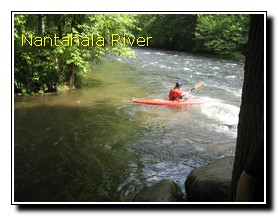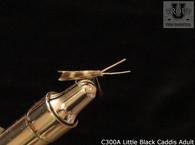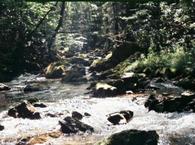
The Nantahala is listed in the Trout Unlimited top 100 trout streams, and it has been featured in major magazines like the Eastern Fly Fishing Magazine and North Carolina Sportsman, etc. It is arguably one of the finest rivers in the South Eastern United States.
Near Beechertown on U.S.Highway 19/74 the Nantahala River takes a turn and just above that turn, is a powerhouse that releases water into the river. The Nantahala River above the powerhouse is designated Delayed Harvest. This portion of the river is freestone with the water provided by countless small tributaries and the run-off, and as such resembles some of the finest streams in the Great Smoky Mountains National Park. The stream is small and overhung with rhododendron as it scampers across the rock strewn bottom creating riffles and small pools. This delayed harvest section is a favorite among fly fishermen because of the great action year round and because of the large populations of trout, including wild brook trout as well as the stocked trout.
The Nantahala River below the powerhouse is an excellent tailwater stream for 8 miles. There large rainbows and browns often reach 20 inches in this portion of the river and they are used to seeing people; and due to the traffic on this portion, they are found near the banks in the little eddies behind fallen logs and boulders. The fishing is best before the water releases about 10:00AM and in the evening after the river traffic has stopped. Float trips as well as wading can be productive but great care should be observed when the water is released from the dam.
Fishing the Nantahala:
Again, we will reiterate, it is important to fish on the hours when there are no paddlers or floaters on the river and fish near the banks as much as possible. The Nantahala River is fertile waters and has superb hatches occurring throughout the entire year. North Carolina State Record Brown Trout came from this portion of the Nantahala, weighing in at 24lbs 10oz!
Spring:
The spring of the year is a great time to fish the Nantahala River as the popular tourist traffic has not started in earnest. Spring sees the great hatches starting in Blue Quill and the Quill Gordons in March followed in April with the March Browns, the Hendricksons and the Black Caddis flies. Fish these patterns in some of the larger sizes like 12, 14, and 16 hook sizes. Of course the Blue Winged Olive hatches are still occurring and imitations of them should be in the smaller hook sizes.
Summer:
In the upper portion of the Nantahala River, small dry flies will work well when fished under the overhanging rhododendron bushes. In the lower portion, starting in May and June, fish the patterns of the BWO’s. Cream Midges, Green Drakes followed by the Light Cahill and Yellow Stone flies later in the summer. Of course, the terrestrials will be effective under the overhanging branches.
Fall:
The Nantahala River tourist traffic has slowed or stopped and the fishing remains good as the leaves are colorful. Start in October BWO’ and Midges in sizes 18 through 24. Nymphs will be the most effective patterns. Also, continue with the terrestrials.
Winter:
Winter fishing can hold up even in the dead of winter especially if the sun warms the water a degree or more. You can expect to have some size 18 through 24 BWO’s and Midges in your fly box. As the winter progresses be sure to have some Black Stone Flies and Streamers in sizes 8 and 10 in your fly box.
U.S. Highway 19/74 Follows the Nantahala River for many miles with a number of pull-offs that provide easy access to the river with very little hiking.
Check out our full color, waterproof map and fly fishing guide measures 11" x 17"
Fly Fishing for Trout in Tailwaters
Fly fishing Strategies that Catch Trout
Trout University free classes, instructional DVDs and much more.





